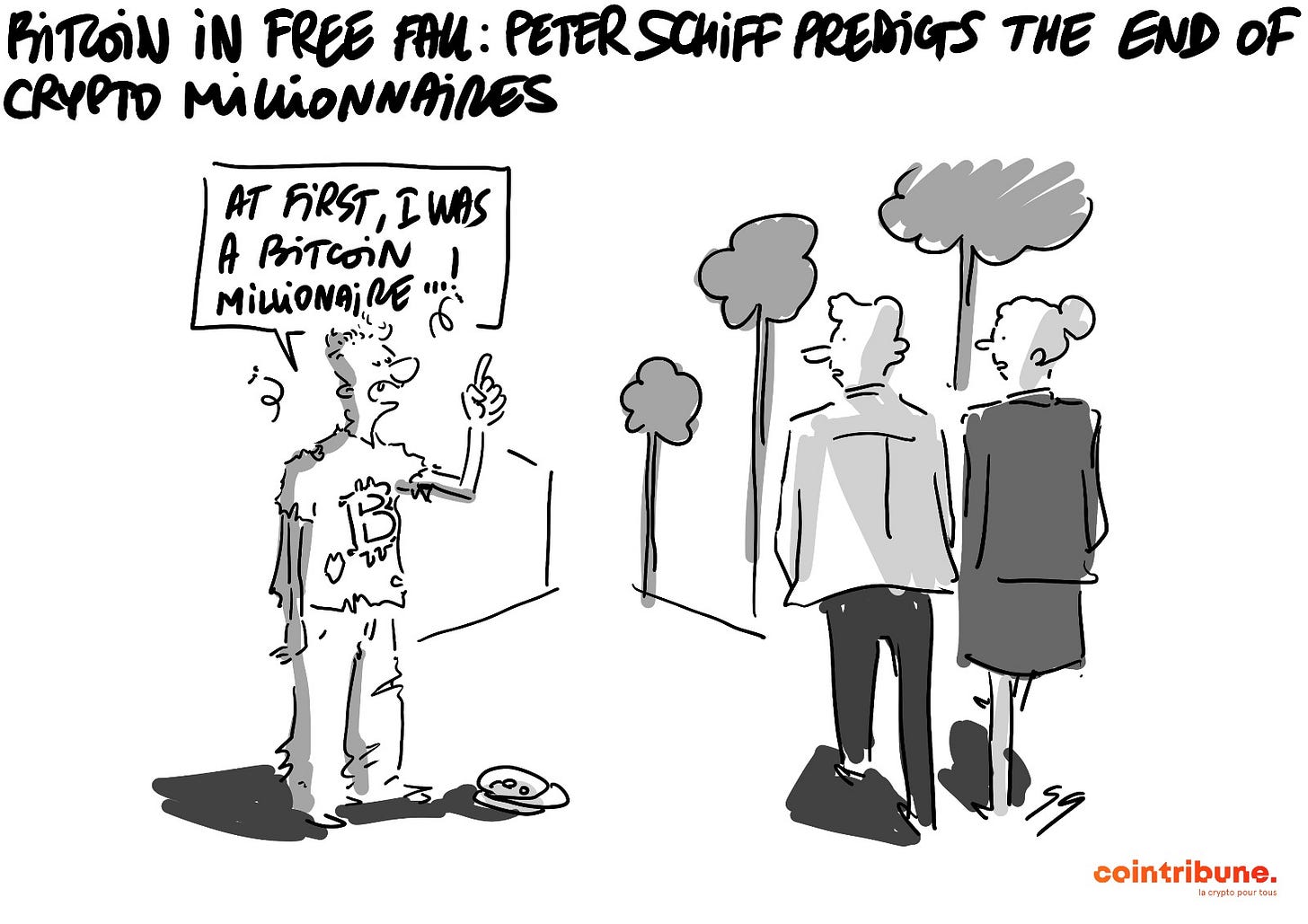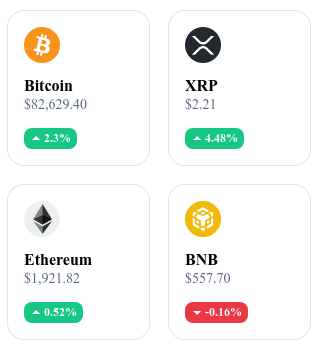🔥 The crypto market in crisis: 45 billion lost in DeFi, BTC under pressure, but Strategy continues to accumulate!
Welcome to the Daily Tribune of Wednesday, March 12, 2025 ☕️
Happy New Year to Cointribu! 🚀
Today is Wednesday, March 12, 2025, and like every day from Tuesday to Saturday, we summarize the news from the last 24 hours that you shouldn't miss!
But first…
✍️ Cartoon of the day:
A quick look at the market…
🌡️ Temperature:
Partially sunny 🌤️
24h crypto recap! ⏱
📉 Bitcoin collapses, Peter Schiff rejoices and announces the end of crypto millionaires
As Bitcoin falls 30% in just a few weeks, dropping below $80,000, Peter Schiff, a well-known BTC critic and gold proponent, didn't hesitate to mock the situation. He claims that many crypto millionaires will soon have to look for a job, highlighting what he sees as Bitcoin's failure as a store of value. This correction is part of a broader economic context, where the Nasdaq 100 has recorded its worst day since 2022. Companies exposed to cryptos, like Strategy (-16.68%) and Tesla (-15.43%), faced heavy losses. Schiff also questions the strategic reserve of BTC announced by Trump, pointing out the high volatility of the asset. In response to these criticisms, some analysts, including Arthur Hayes (BitMEX), defend this correction as a mere step in a bullish market. 🔗 Read the full article
⚠️ Bitcoin in sharp decline: CZ tries to reassure traders
Bitcoin is going through a turbulent phase that worries investors, with a drop of over 4% in a week, hitting a low of $77,527. In the face of the ambient panic, CZ, former CEO of Binance, reminds that "HODLing is never easy" and emphasizes that volatility is part of the natural cycle of cryptos. However, distrust is growing, with some traders accusing platforms of orchestrating these movements to trap retail investors. CZ denies these accusations, stating that no one can truly predict market fluctuations. Meanwhile, Robert Kiyosaki (Rich Dad, Poor Dad) believes this drop is a "historic opportunity", advising investors to take advantage of low prices to accumulate BTC, gold, and silver. 🔗 Read the full article
🌪 DeFi in crisis: $45 billion disappear from the market
The decentralized finance (DeFi) market is experiencing one of its worst crises, with a drop of $45 billion in TVL (Total Value Locked) since its peak in December 2024. Ethereum and Solana, considered solid pillars, are suffering heavy losses. The TVL of Ethereum has dropped by $30.6 billion, despite the growing adoption of spot ETFs and the pro-Bitcoin initiatives of the Trump administration. The drop in memecoins has also contributed to this decline, greatly reducing market liquidity. The hemorrhage continues, with 800,000 ETH ($1.8 billion) leaving exchanges in a week, hinting at a potential discreet accumulation by institutional investors. 🔗 Read the full article
💰 Michael Saylor wants to raise $21 billion to buy even more Bitcoin
Strategy (formerly MicroStrategy) is not backing down and announces a massive plan to acquire more BTC. Michael Saylor unveiled an ATM program that will issue preferred stocks at 8% to raise up to $21 billion. This amount will primarily be used to accumulate more Bitcoin, further strengthening Strategy's position, which already holds nearly 500,000 BTC purchased at an average price of $66,423. The company even plans to raise a total of $42 billion over three years, aiming for a 15% return in 2025. 🔗 Read the full article
Today's crypto: Bittensor (TAO)
Bittensor is an open-source protocol that uses blockchain technology to create a decentralized network for machine learning. This network allows machine learning models to train collaboratively and be rewarded in TAO based on the informational value they bring to the collective. Moreover, TAO offers external access to users, allowing them to extract information from the network while adjusting its activities to their needs.
The native token of Bittensor, TAO, is used to reward contributors to the network based on the value of their machine learning models. TAO holders can also access network information and adjust its activities according to their needs.
Recent performances:
Current price: $263.60 (approximately €247.50)
24-hour change: +8.85%
Market capitalization: $2.23 billion
Ranking on CoinMarketCap: #39
Bitcoin: A growing divide between Europe and the United States
The contrast between U.S. policy and that of the European Union regarding cryptocurrencies is becoming increasingly pronounced. While the United States fully embraces Bitcoin, granting it a strategic place in its monetary policy, Europe is bogged down in the project of a digital euro (CBDC), perceived by many experts as a threat to financial freedoms. This divergence marks a deep ideological rupture on how major powers approach the future of digital assets.
In the United States, President Donald Trump recently signed a presidential decree officially establishing the creation of a strategic reserve of Bitcoin. This text clearly establishes a distinction between bitcoins held by the state and other cryptocurrencies obtained through judicial seizures, such as Ethereum, Solana, or XRP. Unlike the latter, the Bitcoin in this reserve cannot be sold, a decision that underscores the importance placed on this asset. This measure is far from symbolic: it is part of a long-term economic strategy aimed at strengthening Bitcoin's position as a store of value. The decree also provides for the exploration of solutions to increase this reserve, while maintaining budgetary neutrality.
Meanwhile, U.S. banks are now authorized to hold Bitcoin on behalf of their clients, without going through complex regulatory procedures. This evolution reflects a significant shift in the U.S. approach to Bitcoin, which is gradually moving from being a speculative asset to a strategic value within the American economy.
In contrast, the European Union is taking a radically opposite direction. Under Christine Lagarde, the European Central Bank is accelerating the development of the digital euro, a central bank digital currency (CBDC) project. Officially, this initiative aims to modernize the monetary system and facilitate electronic payments, but many analysts fear it could become a financial control tool that might reduce the freedom of European citizens. Unlike Bitcoin, which relies on a decentralized system, the digital euro would give increased surveillance power to the ECB, allowing for detailed tracking of every transaction.
One of the major concerns lies in the programmability of this currency. Some economists and banking sector actors fear that in the future, authorities could impose restrictions on the use of digital funds. A digital euro could, for example, be designed to prevent its use in certain transactions or be programmed to expire after a certain time, thus forcing consumers to spend it. Such measures have been discussed by officials from the International Monetary Fund (IMF) and other financial institutions, including in China, where a similar system is already in place with the digital yuan. Christine Lagarde asserts that the digital euro will not be programmable, but past statements by several economic decision-makers leave doubt about the true intentions behind this project.
In response to this shift, some European countries are starting to express reservations. In the Czech Republic, for example, the governor of the Central Bank has recently suggested adding Bitcoin to national reserves, an initiative that aligns more closely with U.S. policy than with that of Brussels. Poland and Russia are also exploring solutions to integrate Bitcoin into their financial strategies, while other member states remain skeptical about the future of the digital euro.
Refusing to recognize Bitcoin as a strategic asset while only betting on a centralized digital currency, the European Union could find itself disadvantaged compared to an America that encourages innovation and the integration of cryptos into its economy.









